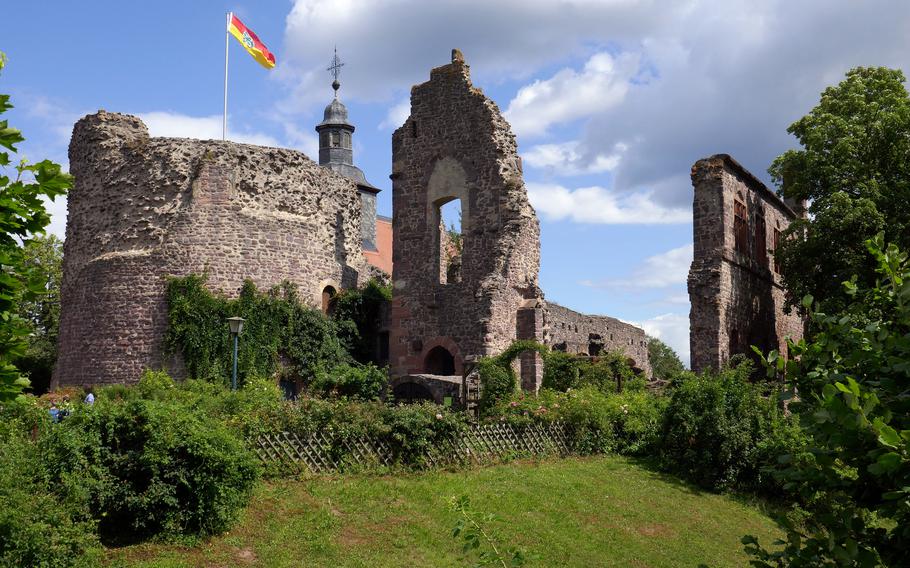
Burg Hayn in Dreieichenheim, Germany, was built in the late 13th century. In pre-coronavirus days, the castle and its grounds were used for medieval markets, concerts and theater, among other things. (Michael Abrams/Stars and Stripes)
A visit to Dreieichenhain is like stepping back in time.
You walk through an old tower gate and stroll down a cobblestone lane. You amble past stone and half-timbered houses and come to a medieval castle before passing under another tower gate.
You feel as if you’ve been transported to the Middle Ages.
But then you become aware of the cars. Poof, the illusion is gone.
That’s sort of how I felt during a recent visit to this small German town, about 30 miles east of Wiesbaden. It was first documented in 1256, but the Turmburg, or tower castle, a unique five-story structure, dates to the 11th century.
I parked outside town, and the first thing I saw was the castle, Burg Hayn, and the reflection of the Untertor, or Lower Gate, in a large pond.
The castle was constructed about 100 years after the original tower was built, incorporating the old keep.
Burg Hayn didn’t have a particularly happy history, being passed on to various noble dynasties through the years, all of which died out.
It fell to ruins and suffered the fate of many other castles as the residents started using it as a quarry.
Today, it’s owned by the local historical society, which also runs the small museum inside.
It’s still a cool place to walk around. I checked out the ruins of the Palas, the former living quarters, the old gravestones and the wheels of an old mill.
In pre-coronavirus days, concerts and a popular medieval market were held on the castle grounds.
At the foot of the castle, the small Thursday market was buzzing with shoppers.
I strolled up Fahrgasse, the town’s main street. Here’s where the stream of traffic hit me. Car after car rolled down the street.
I guess the people here have places to go, and you don’t want to hamper commerce, but all the traffic spoiled the atmosphere.
Nonetheless, I continued up the street past shops and busy cafes to the Obertor, the half-timbered upper gate. It was built around 1350.
The medieval defensive wall still surrounds the whole old town, but unfortunately most of it is inaccessible because houses are built into it, or it’s in people’s yards.
To get away from most of the traffic, I crisscrossed town, walking down narrow lanes, discovering the colorful and varied half-timbered houses.
There are about 100 houses built in that style still standing in Dreieichenhain. The oldest, constructed in 1460, is the Ludwig-Erk-Haus.
Built for the clergy, it was later used as a school and is named after a collector of German folk songs who once lived there.
An imposing half-timbered house is the Saalhof, the former forester’s lodge, built in 1616 with a five-sided stairwell tower.
Also worth seeing is the Trierischer Hof. It was originally built before 1400 and housed the castle’s men-at-arms. It was extended in later centuries.
Hungry after all the walking and car dodging, I was hoping to have lunch at Zur Alten Burg, a popular restaurant at the foot of the castle. But unfortunately, it didn’t open until 5 p.m.
So I grabbed something from one of the market stands and sat on a bench in the dried-out moat and enjoyed the view of Burg Hayn.
Directions: Dreieichenhain is about 30 miles east of Wiesbaden. Take autobahns A66, A3 and A661. From the Kaiserslautern area, it is about 75 miles via autobahns A63, A60, A67 and highway 486.
Times: Anytime, but better in nice weather and the stores are open. The castle grounds are always open. There is a small market on Thursday mornings. The castle museum is open 2 to 6 p.m. on Saturdays and 11 a.m. to 6 p.m. on Sundays and German holidays.
Costs: There is free parking outside the town walls.
Food: A couple of cafes are inside the city walls, plus the Gasthaus Alte Burg at the foot of the castle and El Castillo, a tapas bar, on the castle grounds. Both open at 5 p.m.
Info: The town’s German language-only website is dreieichenhain.de. If you are visiting with small children, there is a nice playground in the dried-out castle moat.